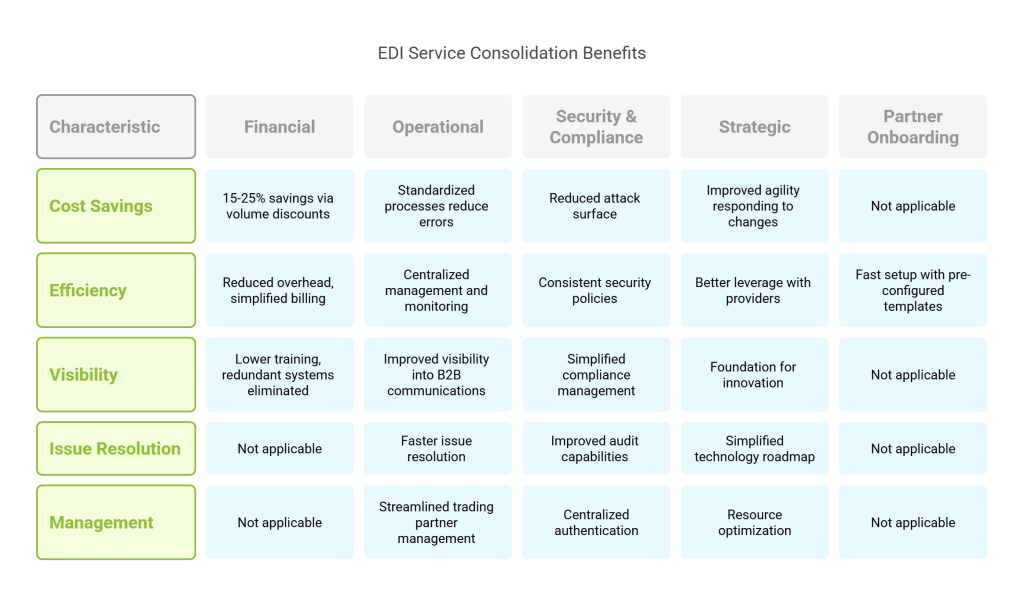Introduction
Don’t Let Your Legacy EDI Provider Hold You Back: Break Free from EDI Provider Limitations
Many businesses feel trapped in relationships with old and outdated legacy EDI providers, often due to historical reasons, departmental preferences, or acquisitions. Switching to a new provider evokes images of disrupted operations, unhappy trading partners, and technical nightmares. This perceived complexity leads many organizations to remain with underperforming EDI providers, enduring subpar service, outdated technology, and excessive costs rather than navigating the perceived migration challenges.
But here’s the truth: you’re not locked in. Switching your EDI provider is not only possible—it’s often straightforward when approached methodically.
More importantly, moving to a better provider and consolidating your EDI services can transform your business operations, reducing costs and improving efficiency..
The good news is that with proper planning and execution, you can successfully transition to a provider that better meets your needs.
According to our internal research, some of our existing customers who switched to Commport EDI and consolidated all their EDI services have a standardized process, making onboarding new trading partners faster and more efficient, reduced overall operational costs by up to 144%, making it a compelling option for businesses looking to optimize their operations.
4 Signs Your Current Legacy EDI Provider Is No Longer Meeting Your Needs

1. Rising Costs Without Added Value
One of the most common indicators that it’s time to consider a new EDI provider is steadily increasing costs without corresponding improvements in service or capabilities. According to a study by Forrester Research, businesses that switched EDI providers reported an average cost reduction of 30% while maintaining or improving service levels.
Analyzing your current legacy EDI provider costs should be a regular practice. Look beyond the basic transaction fees and consider all associated expenses:
- Implementation and onboarding fees
- Monthly or annual subscription costs
- Per-transaction charges
- Maintenance fees
- Support costs (especially if charged separately)
- Integration expenses
- Trading partner addition fees
If these costs have been rising without clear justification or added value, it may be time to explore alternatives. Many modern EDI providers offer more transparent pricing models and better value propositions.
2. Limited Technical Capabilities
Technology evolves rapidly, and your old legacy EDI provider should keep pace with these changes. Signs of technical limitations include:
- Lack of cloud capabilities: Modern EDI solutions leverage cloud technology for greater flexibility, scalability, and accessibility. If your provider is still exclusively offering on-premises solutions, they may be behind the curve.
- Poor integration options: Your EDI system should integrate seamlessly with your other business applications, including ERP systems, CRM platforms, and accounting software. Limited integration capabilities create inefficiencies and manual workarounds.
- Minimal support for modern standards: While traditional EDI standards remain important, your provider should also support newer formats and protocols, including JSON, XML, and API-based integrations.
- Inadequate security measures: With cyber threats constantly evolving, your EDI provider should implement robust security protocols, including encryption, multi-factor authentication, and regular security audits.
- Limited scalability: As your business grows, your EDI solution should scale accordingly without significant disruptions or cost increases.
3. Poor Customer Support and Service
EDI is critical to your business operations, and when issues arise, you need prompt and effective support. Warning signs of inadequate support include:
- Long response times to support tickets or calls
- Limited support hours that don’t align with your business operations
- Inexperienced support staff who can’t resolve complex issues
- Lack of proactive monitoring and issue resolution
- Poor communication during outages or system changes
- Limited training and onboarding assistance
4. Inability to Support Business Growth
As your business evolves, your EDI needs will change. Your old legacy EDI provider should be a partner in this growth, not an obstacle. Signs that your provider can’t support your growth include:
- Difficulty adding new trading partners: The EDI provider enrollment process should be streamlined and efficient. If adding new partners is consistently time-consuming or problematic, your provider may be limiting your business growth.
- Geographic limitations: If you’re expanding into new regions, your EDI provider should support international standards and have experience with global trading partners.
- Limited transaction types: As your business relationships become more complex, you may need support for additional EDI transaction types. Your provider should accommodate these needs without significant additional costs or complications.
- Inflexible contract terms: Long-term contracts with rigid terms can prevent you from adapting to changing business requirements. Look for providers that offer more flexible arrangements.
Advantages of Consolidating All Your EDI Services to a Single Provider

1. Financial Benefits of Consolidation
The financial advantages of consolidating EDI services under a single provider are substantial:
- Volume discounts: Consolidating transaction volume with one provider typically results in better pricing. Research by Gartner indicates that businesses can achieve 15-25% cost savings through volume consolidation alone.
- Reduced administrative overhead: Managing multiple providers requires additional staff time for vendor management, contract negotiations, and relationship maintenance. Consolidation eliminates these duplicative efforts.
- Simplified billing and accounting: Working with a single provider streamlines accounts for payable processes and makes budgeting more predictable.
- Lower training costs: Staff only need to learn one system rather than multiple platforms, reducing training expenses and improving efficiency.
- Elimination of redundant systems: Many organizations maintain overlapping capabilities across different EDI systems, creating unnecessary costs.
2. Operational Efficiencies
Beyond cost savings, EDI service consolidation offers significant operational benefits:
- Standardized processes: Using a single EDI system allows for consistent processes across the organization, reducing errors and improving efficiency.
- Centralized management: A consolidated approach enables centralized monitoring, management, and control of all EDI activities.
- Improved visibility: With all EDI transactions flowing through a single system, businesses gain comprehensive visibility into their B2B communications.
- Faster issue resolution: When problems arise, having a single provider simplifies troubleshooting and accountability.
- Streamlined trading partner management: Consolidation eliminates the need for trading partners to connect to multiple systems, simplifying their experience and reducing support requirements.
3. Enhanced Security and Compliance
Security concerns are increasingly important in EDI operations, and consolidation offers several security advantages:
- Reduced attack surface: Each EDI system represents a potential entry point for cyber threats. Consolidation reduces the number of systems to secure and monitor.
- Consistent security policies: A single provider allows for uniform security protocols across all EDI transactions.
- Simplified compliance management: Meeting regulatory requirements becomes easier when all EDI activities are managed through one system with consistent controls and documentation.
- Improved audit capabilities: Consolidated systems typically offer better audit trails and reporting for compliance purposes.
- Centralized authentication: User access management becomes more straightforward with a single system, reducing the risk of unauthorized access.
4. Strategic Advantages
The benefits of EDI service consolidation include streamlined processes and enhanced visibility across B2B operations. Beyond immediate operational and financial benefits, consolidation offers strategic advantages:
- Improved agility: A consolidated EDI approach enables faster response to changing business requirements and market conditions.
- Better leverage with providers: Consolidating volume with one provider gives you greater negotiating power for pricing, service levels, and feature requests.
- Foundation for innovation: A modern, consolidated EDI platform provides a foundation for future innovations in supply chain management and B2B integration.
- Simplified technology roadmap: Planning for future EDI capabilities becomes more straightforward with a single platform to consider.
- Resource optimization: IT and business resources can focus on maximizing the value of one system rather than maintaining multiple platforms.
5. Faster onboarding of new trading partners
Perhaps the most compelling reason for EDI consolidation is the dramatic improvement in partner onboarding speed. A centralized EDI integration platform enables you to set up new trading partners for data movement within minutes, with EDI and XML data transformation taking just hours rather than weeks. This acceleration occurs because consolidated systems come pre-loaded with B2B connectors that provide hundreds of pre-configured, ready-to-deploy communication templates to major trading partners.
Why Commport EDI Solutions Stands Out Among Top EDI VAN Providers
Among established EDI VAN providers, Commport distinguishes itself through a combination of technical flexibility, transparent business practices, and proven performance. With over 6000 customers, 5,000+ trading partners, and processing exceeding 140,000 daily transactions, Commport delivers comprehensive EDI solutions that address the evolving needs of modern businesses.
1. Flexible integration with ERP and CRM systems
Commport’s integrated EDI seamlessly connects with all ERP systems and other business applications, creating fluid information exchange between different departments. Unlike competitors offering limited compatibility, Commport provides:
- Complete integration with inventory management, order processing, and shipping systems
- Custom interfaces for businesses with specialized requirements
- Support for multiple EDI formats, including ANSI X12, EDIFACT, XML, and custom flat files
This flexibility empowers businesses to maintain existing workflows while enhancing efficiency. Commport’s integration approach creates a “pipeline between internal and partner-facing supply chain processes”, allowing organizations to analyze their EDI data alongside other enterprise data.
2. Transparent EDI VAN pricing and service tiers
Unlike traditional VAN providers that employ complicated pricing structures with hidden fees, Commport offers straightforward pricing options. This stands in sharp contrast to competitors that charge implementation fees, onboarding fees, migration fees, compliance fees, trading partner setup fees, and exorbitant overage charges.
Commonwealth, a longtime Commport customer, specifically cited “confidence in them due to their superior VAN uptime, secure and reliable EDI processing as well as their prompt customer support and service delivery” as reasons for choosing Commport over other providers.
3. Proven track record with global clients
Commport has established itself as a trusted provider through decades of reliable service. Their experience spans diverse industries including Government, Healthcare, Financial, Food and Beverage, and Retail.
One client testimonial particularly highlights how “having the translation occur at Commport streamlined the EDI portion of the ERP project”, allowing their consultants to remain focused on core implementation activities. Furthermore, their long-standing client relationships demonstrate Commport’s ability to adapt to changing market needs while consistently delivering value.
Conclusion
EDI consolidation represents a strategic decision, fundamentally transforming how businesses operate across their supply chains. Throughout this article, we’ve seen how fragmented EDI systems create confusion, increase costs, and introduce significant errors into critical business processes. Specifically, research confirms that 93% of organizations struggle with their current implementations, while 60% of B2B transactions face disruptions due to data-related issues.
Centralizing your EDI operations with a single provider addresses these challenges head-on. Most importantly, this approach delivers immediate benefits through streamlined support, enhanced compliance capabilities, and dramatically faster partner onboarding. The evidence clearly shows that consolidation eliminates the 30+ day onboarding delays that currently plague 40% of enterprises.
Commport EDI stands apart from other providers thanks to its flexible integration capabilities, transparent pricing structure, and established track record serving 6000+ customers across multiple industries. Their platform processes over 140,000 daily transactions while supporting diverse EDI formats and seamless connections with all major ERP systems.
Long-term benefits prove equally compelling. Companies that consolidate their EDI services report cost savings up to 144%, gain real-time visibility across all transactions, and future-proof their supply chain infrastructure against evolving market demands. One organization even retained over $100,000 in reimbursements after improving data accuracy through consolidation.
The path forward appears clear for businesses struggling with fragmented EDI systems. Switch to Commport EDI Solutions today and transform your supply chain operations from a source of frustration into a strategic advantage. Your trading partners will notice the difference, your IT team will thank you, and your bottom line will reflect the wisdom of your decision.
Commport EDI VAN Solutions
Need Help? Download: Commport's EDI Buyers Guide
Unlock the full potential of your supply chain with our comprehensive EDI Buyer's Guide — your first step towards seamless, efficient, and error-free transactions
Frequently Asked Questions
Consolidating EDI services with a single provider offers centralized support, improved compliance with global standards, and faster onboarding of new trading partners. It also reduces operational costs, provides real-time visibility into transactions, and future-proofs your supply chain infrastructure.
Outdated EDI systems can struggle to keep pace with growing transaction volumes, leading to slow processing, system crashes, and supply chain disruptions. They often lack flexibility to adapt to new business needs, have limited scalability, and may rely on outdated security protocols, making them vulnerable to data breaches.
EDI is widely used across various industries, including retail, manufacturing, healthcare, logistics, and finance. These sectors rely on EDI to enhance efficiency in processes such as order processing, inventory management, and invoicing while ensuring compliance with industry standards.
Commport EDI distinguishes itself through flexible integration with ERP and CRM systems, transparent pricing structures, and a proven track record with global clients. They process over 140,000 daily transactions and offer support for multiple EDI formats, making them adaptable to diverse business needs.
Long-term benefits of EDI consolidation include significantly lower operational costs, with potential savings of up to 144%. Businesses also gain real-time visibility into all transactions, enabling proactive issue resolution and data-backed decision-making. Additionally, a consolidated





